#men aboard hms victory
Text
Who served aboard HMS Victory
Well we would assume that if we have a British ship that the majority is British. However, other nations also served aboard the lovely and famous HMS Victory, which was also the case on other ships. But let me show you which other nations were there during the early 19th century.
22 Americans
7 Dutch
6 Swedes
4 Italians
4 Maltese
3 French (all volunteers)
3 Norwegians
3 Germans
2 Swiss
2 Portuguese
2 Danes
2 Indians
1 Russian
1 African
9 from the West Indian Islands
All in all, a really interesting mix.
62 notes
·
View notes
Text

HMS Montagu aground on Shutter Rock, suffering a 91-foot (28 m) gash on her starboard side. Unable to free herself from the rocks,
At 02:00 on 30 May 1906 , Montagu ran aground on Shutter Rock, suffering a 91-foot (28 m) gash on her starboard side. Unable to free herself from the rocks, she slowly filled with water; twenty-four hours later, her starboard engine room and all of her boiler room were flooded, among others. Her crew counter-flooded the port engine room to prevent her from listing further to starboard. Divers inspected the hull to determine the extent of the damage, which proved to be more serious than initially expected. The bottom of the ship also received extensive damage, including several other holes and the port propeller shaft having been torn from the hull. The starboard bilge keel was also ripped from the hull, as was the rudder. The wreck rested on a fairly even bottom, so there was hope that the ship could be refloated
Since the Royal Navy had no dedicated salvage unit, it turned to Frederick Young, a former Royal Navy captain who now worked as the chief salvage officer of the Liverpool Salvage Association. Young was at that time the foremost expert on marine salvage in Britain, so he was hired to advise Admiral Sir Arthur Wilson the commander of the Channel Fleet, who had no experience in salvage operations. The navy initially hoped to lighten the ship by removing the medium and small-caliber guns and other equipment that could be easily taken off and then to pump out the water so that the holes in the hull could be patched. By the end of June, some twenty pumps had been assembled on the scene, with a total pumping capacity of 8,600 tonnes (8,500 long tons; 9,500 short tons) of water per hour. Difficulties with pumping, owing in part to the subdivision of the internal compartments and the need to reflood the ship during high tide to keep her from suffering more damage before the hull could be patched, led the salvors to give up the operation
Wilson next sought to remove armour plate from the sides of the ship and to erect a series of caissons , at which point a powerful air pump would be used to blow the water out of the hull. The caissons repeatedly broke free even in mild seas, and the air pump failed to have the desired effect. Her sister ship Duncan herself ran aground whilst trying to help the salvage effort, though she was successfully freed. At the end of the summer of 1906, salvage efforts were suspended for the year, with plans to resume them in 1907. However, an inspection of the ship conducted from 1 to 10 October 1906 found that the action of the sea was driving her further ashore and bending and warping her hull so that her seams were beginning to open, her deck planking was coming apart, and her boat davits had collapsed. Having failed to refloat Montagu, the navy decided to abandon the project. Further material was removed from the wreck, including her main battery guns, which were later re-used in other vessels.The Western Marine Salvage Company of Penzance completed salvage of the wreck for scrap metal over the next 15 years. The court martial convened for the affair blamed the thick fog and faulty navigation for the wreck. The trial was held aboard HMS Victory . The ship's captain, Thomas Adair and the navigation officer, Lieutenant James Dathan, were severely reprimanded, with both men being dismissed from HMS Montagu; Dathan lost two years of seniority in rank as well.The wreck site, which now amounts to little more than some armour plate on the sea floor, is a popular diving location. Divers have also located parts of her gun turrets and shells that were not recovered during the salvage operation. In September 2019 the British Government granted the wreck site—including the steps which had been chiseled out of the cliff during the salvage effort protected status
12 notes
·
View notes
Note
Ship OCs! Original Ships! Tell us more!
yess my OSs!! everyone should have some, it's good for the soul! anyway, here are short bits about each of them:
HMS Orca is a stealth ship. She is small by frigate standards, fast and remarkably well-manoeuvrable. She was designed by an unknown gentleman, who died before he could see her sent to construction - but luckily his friend, a lieutenant, noticed the state-of-the-art design and made sure the project was completed. She is almost entirely black - originally with white stripes along the broadsides - and her figurehead is a grotesque leviathan-looking whale, all part of the original design. This rather morbid look combined with her purpose as an intelligence/stealth vessel are why she is considered to cause bad luck for those who might see her from shore. Among her crews, however, she has had a good reputation as an easy ship to work and steer and one which usually sees little violent action. Being as useful as she is, she changes hands often, but the man who knows her best is still the one who first gathered her design off of his late friend's desk - the lieutenant in question became captain on her deck.
HMS Nettle, "Netty," or "Stinging Weed," as she's lovingly referred to by her crew, is a ship in chronic disrepair. Nigh-on seven different architects were involved in her conception and none of them particularly considered it a labour of love. She was commissioned by a trading company of two wealthy Londoners, however one of them died, leaving behind a mountain of gambling debts. His partner sold the half-finished ship to the admiralty for pennies, in whose hands she was hastily put together and thrown into action well before she was ready. Despite a dismal beginning, this brave leaking tub of a boat refuses to die, limping from one unlikely victory to another. No one wants to be saddled with her too long, but the men who know her remember her fondly - for one thing, she has very spacious lower decks. She has a yellow stripe along her broadside and a figurehead of a unicorn, which lost half its horn in an unhappy collision. Is she cursed? Is she blessed? Something in between? Who knows!
HMS Emperor Hadrian is a beast. Not that the admiralty would agree - for a first-rate frigate, 99 is a pitiful number of guns, so upon her first inspection, four savvy crewmen snuck a 6-pounder aboard to make her endowment a nice, round 100. She was designed by a Kentish nobleman who fancied himself a salt-of-the-earth shipwright on his days off. Thankfully, somewhere in the process an actual shipwright stepped in. Hadrian is painted dark blue with a big yellow stripe and her figurehead is the emperor himself, with a exceptionally chiseled brown beard that some drunk youths attempted to 'shave' once. Despite her size, she sits quite high in the water, which would make her fast and thus very handy - unfortunately, she has major problems with stability, so any dynamic action is always marred by the threat of listing. She has a long history. Hadrian was once captured as a Spanish prize, before her crew managed to take back control in a violent mutiny. The victorious tars carved their initials into her foremast, preserved through several repaints and repairs.
It's not entirely clear what King, The King's Challenger is supposed to be challenger of. Similarly undecided is whether the challenge is meant to be issued on the king's behalf or to the king himself. As her name suggests, she changed loyalties a lot. Built by the Dutch, she was bought by a Spanish merchant, then boarded and stolen by pirates off St. Lucia. When docked on New Providence, she was commandeered under the cover of night by a Welsh privateer without a single shot being fired. She has stayed under his command ever since, attacking easy prizes and ransoming letters all over the Irish Sea and Northern Atlantic. Her privateer captain has a dismal reputation among the navy, but both he and his beloved Challenger are welcome characters in alehouse gossip. Those who know the ship also marvel a little at her success, given her tiny size. She is an experienced, predictable and a very well-balanced ship, with a chequerboard pattern of white and red along her miniature broadside and an effigy of St. Catherine as her figurehead.
#thank you so much for the ask!!#I have unreasonable amounts of fun writing about ships#although english spelling is a pain#ask#echo
13 notes
·
View notes
Photo
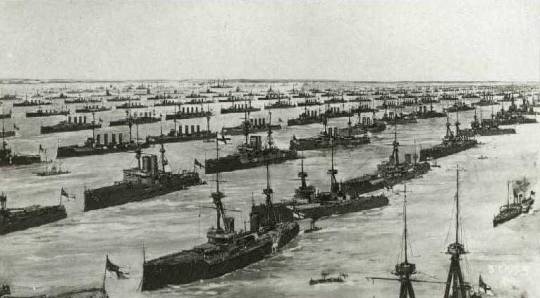
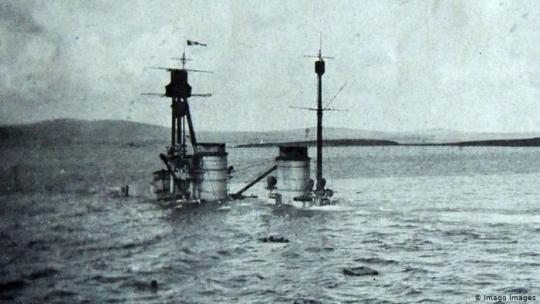
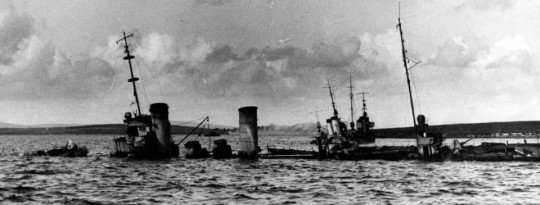

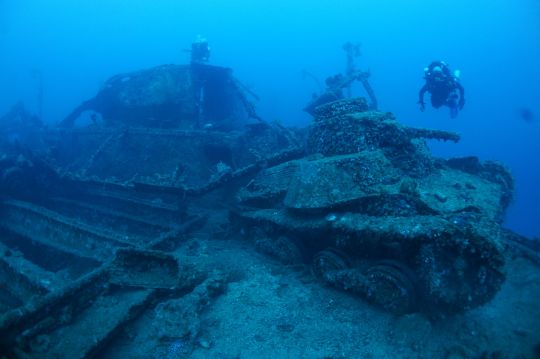
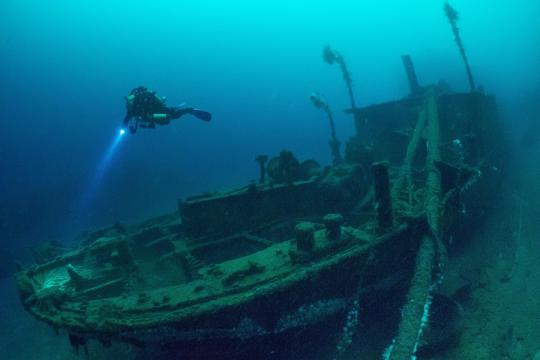
On 21st of June 1919, 72 warships of the German fleet were scuttled in Scapa Flow, Orkney.
It was the single greatest loss of warships in history, and the sailors killed that day were the last fatalities of World War One. On the morning of Sunday 21 June, the British fleet steamed out on exercise. Hundreds of miles away, in Paris, the wrangles over the peace treaty to officially end the Great War were reaching a climax. The fate of the magnificent German warships was due to be decided.
The French and the Italians wanted some of the ships for themselves but the Americans did not approve and nor did the British who wanted them all destroyed.
The German commander, Admiral Ludwig von Reuter, guessed that his ships were about to be seized as spoils of war and divided up between the victorious Allies. He felt duty-bound not to let that happen.
At 10:30 von Reuter’s flagship, Emden, sent out the seemingly innocuous message - “Paragraph Eleven; confirm”. It was a code ordering his men to scuttle their own ships.
Beneath decks, German sailors immediately began to open seacocks - valves that allow water in - and smash pipes. The Germans took to small boats to escape their sinking ships. From one of them Admiral von Reuter was taken aboard HMS Revenge.
Armistice Day is remembered as the day World War One ended, but for naval historians the greatest victory came 10 days later. Operation ZZ was the code name for the surrender of Germany’s mighty navy.
For those who witnessed “Der Tag” or “The Day” it was a sight they would never forget - the greatest gathering of warships the world had ever witnessed.
Scapa Flow is now a mecca for divers all over the world to explore.
27 notes
·
View notes
Text
Sleeping at sea
Just before dark, we took the bearings of the frigate, and stood the same course as she was doing, and then we sat down to a plentiful meal to which we did justice. I then divided the boat's crew into watches, went down into the cabin, and threw myself on the standing bed-place, of which there was but one, with all my clothes on; the men who had not the watch went down, and turned in in the cuddy forward, where the seamen usually sleep.
— Frederick Marryat, Percival Keene
One of the most charming definitions I've learned from Marryat's books is standing bed-place, which appears in several of his novels to describe a bunk, a sleeping place fixed against the walls of a cabin of a ship. It's a very nautical use of the word "standing," in the sense of standing rigging, which are comparative fixtures that support the masts, vs. running rigging which are in constant use to trim the yards and make or shorten sail. (A "running" bed-place would be a hammock, which is easily removed and stowed away).
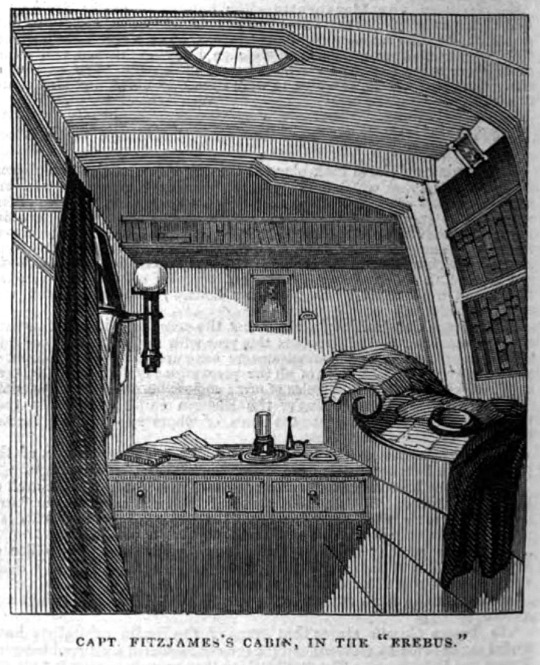
The standing bed-place of Captain James Fitzjames, as shown in the Illustrated London News, May 24th, 1845.
Marryat almost certainly slept in a standing bed-place in his nearly 25 years of service in the Royal Navy, but the bed he describes in his cabin in The King's Own is a hanging cot, which is "swinging and jerking up to the beams" in rough seas during a wild chapter where Marryat puts his story aside to document the real-life experience of writing his book in trying circumstances—"I am seated in the after-cabin of a vessel, endowed with as liberal a share of motion as any in his Majesty's service: whilst I write I am holding on by the table, my legs entwined in the lashings underneath, and I can barely manage to keep my position before my manuscript."
With his ship being the 28-gun HMS Ariadne[1], Marryat may have had a hanging cot like these for junior officers aboard the famous HMS Victory:

As captain, Marryat's cabin was more nicely appointed, and he had a book collection to rival that of Fitzjames, although the storm and careless fitting of the half ports in the dockyard threaten it in The King's Own:
I have just been summoned from my task, in consequence of one of the battens, which secured my little library, having given way to the immoderate weight of learning that pressed upon it: and, as my books have been washed to and fro, I have snatched them from their first attempts at natation. Smith's Wealth of Nations I picked up first, not worth a fig; Don Juan I have just rescued from a second shipwreck
Marryat's young midshipmen do not start out with standing bed-places or hanging cots, and must learn to climb into their hammocks— and avoid those who would maliciously cut them down. Here, Frank Mildmay takes revenge on a cockpit bully in an illustration by H.R. Millar:
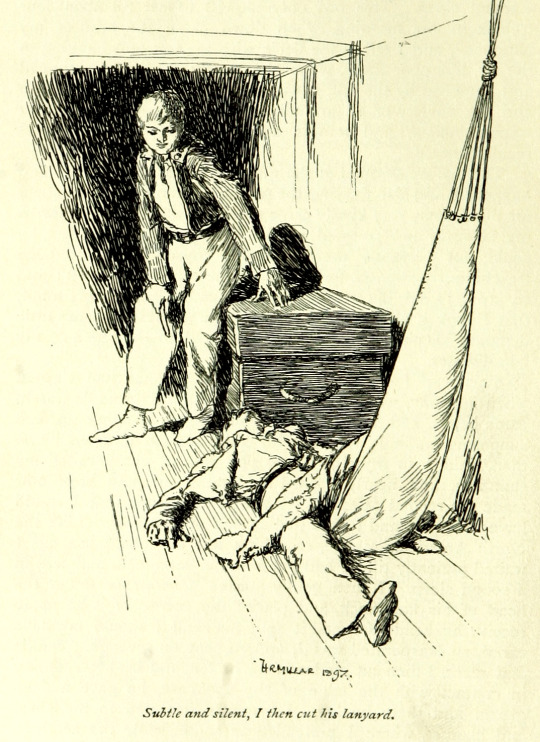
I then gently pushed a shot-case under the head of his hammock, and placed the corner of it so as to receive his head; for had it split his skull I should not have cared, so exasperated was I, and so bent on revenge. Subtle and silent, I then cut his lanyard: he fell, and his head coming in contact with the edge of the shot-case, he gave a deep groan, and there he lay. I instantly retreated to my chest and blanket, where I pretended to snore, while the sentinel, who, fortunately for me, had seen Murphy cut me down the first time, came with his lanthorn, and seeing him apparently dead, removed the shot-case out of the way, and then ran to the sergeant of marines, desiring him to bring the surgeon's assistant.
— Frederick Marryat, Frank Mildmay
(Louis J. Parascandola calls Mildmay "Marryat's coldest hero" for a reason[2].)
In a more lighthearted vein, Newton Forster has a hammock-related revenge visited on a group of soldiers aboard an East Indiaman, who have been using the ship's chickens for cockfighting. The captain waits for them to practice musketry drills on deck, and then has the boatswain pipe 'All hands, air bedding'.
The ship was hauled close to the wind, which was light. At the pipe, the sailors below ran up the hatchway, and those on deck threw down their work. In a minute every hammock was out of the netting, and every seaman busy at unlashing.
"Now, major, we had better go into the cabin," said Captain Oughton, laughing. "I shall, I can assure you."
Beds and blankets which are not aired or shook more than once a month, are apt to be very full of what is termed fluff and blanket hairs, and they have a close smell, by no means agreeable. The sailors, who had an idea that the order had been given inconsiderately, were quite delighted, and commenced shaking their blankets on the forecastle and weather gangway, raising a cloud, which the wind carried aft upon the parties exercising upon the quarter-deck.
— Frederick Marryat, Newton Forster
A first mate is entertained by the spectacle and explains that bedding is never aired unless the ship is before the wind, and as the infantry officer struggles to dismiss his men he alludes to “a great many little men” being dismissed from the bedding. (It’s just as horrifying as you would expect).
[1] Lloyd, Christopher (1939). Captain Marryat and the Old Navy, p. 239-249 and
Meyerstein, E.H.W. (1935). "Captain Marryat and the Ariadne" The Mariner's Mirror Vol. XXI No. 3, July 1935, p. 285-304
The wikipedia article about HMS Ariadne (1816) leaves much to be desired.
[2] Parascandola, Louis J. (1997). "Puzzled Which to Choose": Conflicting Socio-Political Views in the Works of Captain Frederick Marryat. There’s a very good analysis of Marryat’s most autobiographical character.
#frederick marryat#captain marryat#age of sail#royal navy#naval history#bedding#hammocks#standing bed-place#cots#another cameo for known marryat fanboy james fitzjames#hms ariadne#the king's own#percival keene#frank mildmay#newton forster#biography#illustration#james fitzjames#franklin expedition
67 notes
·
View notes
Text
Shannon vs. Chesapeake
Think of all the things you can do in 15 minutes. You can eat a snack, take a shower, do some quick exercises, do a face mask, it’s really up to you. I think I’ll use a pasta meal prep for this purpose, as it’s something I frequently do in 15 minutes. In the grand scheme of things, it isn’t a lot of time, but this of course depends on what it is you’re doing in 15 minutes. The first of June, 1813, saw one of the bloodiest and shortest naval battles in history- it lasted just under 15 minutes. I’m going to walk you through the history of those 15 minutes- today we’ll be travelling 207 years to the past, off the coast of Boston. Mind the cannonballs.
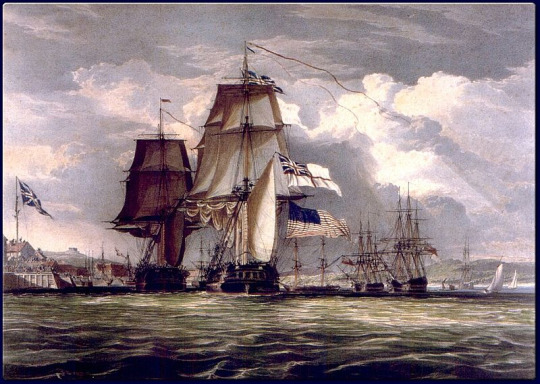
Now the Chesapeake so bold, sailed from Boston we’ve been told, for to take the British frigate neat and handy-o
The people in the port all came out to see the sport
And the bands were playing Yankee Doodle Dandy-o
The British frigate’s name, which for the purpose came to cool the Yankee courage neat and handy-o
Was the Shannon: Captain Broke
All her men were hearts of oak
And at fighting were allowed to be the dandy-o
HMS Shannon was a Leda-class frigate, a lady built for war with an armament consisting of 38 guns numeric and 52 guns in actuality at the time of her 1813 battle. She was built in 1806 at Frindsbury and completed at Chatham, Kent. Captain Phillip Bowes Vere Broke would command her from her launch up until her infamous battle in the War of 1812. Broke ran a tight ship, his crew was extremely disciplined and would participate in daily drill exercises which made them sharp-eyed and fast-handed. Among Shannon’s victories was the 1808 capture of the French ship Thétis (she later became HMS Brune), however this was not her most memorable capture.
USS Chesapeake was a 38-gun frigate much like Shannon, commanded by Captain James Lawrence. She was slightly older and larger than Shannon and was just as powerful. During the War of 1812 she was quite successful, capturing several British merchant ships and ready to take more. How convenient it was for Shannon to be patrolling the Boston coast the same evening as Chesapeake.
It’s the first of June, 1813. Shannon is running low on provisions, yet eager to take one more American ship. Our fiery Captain Broke had his eyes on Chesapeake, and sent out a message to Captain Lawrence challenging him to an exchange of broadsides. Lawrence never received this message. When Shannon and Chesapeake met at half past five in the evening, they entered into something of a standoff, ending just before six o’clock that same evening. Note: this would be a good time to start our pasta.
As we’re boiling the water, Shannon fires the first shot into a gunport on Chesapeake. Her fire was deadly. She was carrying 32-pounder carronades which fired into her opponent’s helm and foremast, then Chesapeake was blown into Shannon; her stern colliding near Shannon’s bow and becoming trapped on her anchor.
The fight, it scarce begun, ‘ere they flinched from their guns
Which at first they started working neat and handy-o
Then brave Broke, he waved his sword, crying “Now, my lads, aboard!
And we’ll stop their playing Yankee Doodle Dandy-o!”
The pasta has now begun to cook. Before Shannon’s crew boarded Chesapeake, Captain Lawrence was shot and killed by a sniper. The Shannons are now boarding the American ship (whose crew had “flinched” under fire) on the order of Captain Broke. Mr. William Stevens, Shannon’s boatswain, lost his arm in his attempt. He would later die of his injuries. Aboard Chesapeake it was hand-to-hand combat between the opposing sides. While it seemed the rest were distracted, Shannon’s First Lieutenant Watts made an attempt to raise the British colours on Chesapeake, but his efforts were futile: he was shot in the head and killed. Another of Shannon’s officers, midshipman John Samwell, was shot in the leg and succumbed to his injuries later.
They no sooner heard the word than they quickly jumped aboard
And hauled down the Yankee colours, neat and handy-o
Notwithstanding all their brag, now the glorious British flag
At the Yankee mizzen peak was quite the dandy-o
Let’s chop some veggies now. Chesapeake’s crew outnumbered the Shannons and wanted to use this to their advantage. A few American sailors snuck up on Broke, one of whom he managed to kill before sustaining a critical head wound at the hand of another. With Shannon’s First Lieutenant dead and her captain in grave danger, command of the vessel fell to 22-year-old Second Lieutenant Provo Wallis, a Halifax native who spent his life in the Navy. He was going to bring her home.
Here’s a health, brave Broke, to you, to your officers and crew
Who aboard the Shannon frigate fought so handy-o
It’s time to start the sauce. From my understanding as a non-American, the slogan of the American Navy is “Don’t Give Up the Ship,” which, of course, are the dying words of Captain Lawrence. Chesapeake’s casualties vastly outnumbered Shannon’s, and when the American sailors realised they could stand no more chance, they surrendered their ship.
By now, our pasta is finished and so is the battle. Now-Commander Provo Wallis sailed his ship quickly and quietly back to Halifax- she was badly injured and could not risk being seen by another American ship- with the Chesapeake in tow as the prize. They made it to Halifax Harbour on the morning of the 6th of June, a Sunday. St. Paul’s Church, which today is the oldest still-standing structure in Halifax, was filled with its congregation. Word caught on that an American ship was taken and that a Haligonian was at the victor’s helm, and within minutes the entire church was emptied as civilians rushed to the water. The sight of the captured Chesapeake arriving before Shannon incited a rupture of cheers and celebration from the huge crowd gathered at the waterfront, a celebration which has yet to be matched.

The tale of the Shannon and the Chesapeake, the Battle of Boston Harbour, is as infamous as it is because it caused so much bloodshed in so little time. It is Halifax folklore that at the north side of Province House sits one of Shannon’s guns (note: I researched this and found the gun to be too large). Provo Wallis, the young officer from Halifax, was celebrated as a city icon and would later be promoted to Admiral of the Fleet, living to the age of 100. Boatswain Stevens and midshipman Samwell are both buried in Halifax’s Old Burying Ground, their headstone can still be seen in the foyer of St. Paul’s Church. Captain Broke later recovered from his injuries and would go on to command another vessel, a little bomb ship by the name of HMS Erebus.
#hms shannon#hms chesapeake#war of 1812#battle of boston harbour#halifax#god i hope that read more works#it's shannon day!!!
87 notes
·
View notes
Text
🌙 — ALL ABOARD ! The HMS PROMETHEAN welcomes ( JOHN “JACK” FOX ) to the expedition in their capacity of ( THE IDOL ). They are ( 34 YEARS OLD & CISMALE ) and might be painted as ( GARRETT HEDLUND ). When you strike up an acquaintance, address them as ( HE/HIM ). Their deeds on land prece their arrival — people say they are ( CHARISMATIC, HEROIC, DARING ) but ( AMBITIOUS, NARCISSISTIC, GUILTY ) when the tide turns. Their purpose aboard the Promethean falls in line with ( FURTHERING HIS CAREER IN THE MILITARY, AND PUTTING DISTANCE BETWEEN HIMSELF AND THE GHOSTS THAT HAUNT HIM ).

FUTURE PLOT POINTS
NOT A SAINT ; BUT DO I HAVE TO BE?
There is nothing more tragic than a good man who is transformed by a decision that takes seconds and minutes to make. I want Jack to be forced to reckon with the idea of good and evil as they exist within him--is he still a good man? It wasn’t his hand that brought about the end of his superior officer’s life, was keeping it withindrawn, at his side as the man bled out before him, a crime equal with murder? If he comes to the conclusion that he is no longer a good man, or potentially has never been a good man, how will he reconcile that knowledge? Will he lean into his dark impulses? I would really like to see him wrestle with his guilt, and use that battle to come to some sort of conclusion, some sort of decision that parallels the one he made that day.
YOU USED TO BE ALIVE. NOW YOU’RE ALMOST MYTHIC.
I’m very interested in his title--the idol. I want to explore Jack’s relationship to his public image, this image that other people have of him in their mind. He is the ideal soldier, a shining bastion of British manhood and honor, the man that boys want to grow up to be, and women secretly wish that their husbands were--I want to explore if he buys into his own mythos, and if so, how would he react once it started to fray at the seams? Would he still be the ideal solider if the all of the military guidelines suddenly didn’t cover a particular situation? Who is he without his uniform, without the ceremonial sabre at his side? When there is nothing to be gained, and everything to be lost?
THE WOUND WILL TAKE YOU THERE. IT IS A BLOOD TRAIL.
I want to know what would happen if someone found out the truth about what he did to advance through the ranks. What lengths would he go to in order to keep his career intact? Would his ambition, his desire to keep advancing, overwhelm any sense of decency he has left? Would he try to justify what he did? He’s very careful to keep his shiny veneer in public, to appear to his men as every bit the bronzed statue who cuts a heroic figure, so how would he react if someone saw the places where that bronze had started to patina, to oxidize?
WRITING SAMPLE
“Why did you decide to venture to the Arctic on this expedition?”
He smiles at the officer who had asked the question--he’s been at this long enough that he’s learned to distinguish between the pointed questions of envious soldiers, the kind that fix their gaze directly between his rigidly held shoulder blades as soon as he walks in the other direction, as if they could reach past his spine and tear out his heart with their eyes alone, and the questions of the starry eyed acolyte. This officer appears to be the former--Jack watches as he doesn’t so much as sip from his glittering flute of champagne, so much as throw back a portion of it as if it were a pint. He fixes the man with the same expression he reserves for members of the admiralty--confident enough to go out and get them a victory, to betray an absolute belief in the self, but humble enough to never claim that victory for himself alone. A smile that seems to say empire, above all else, without him ever having to speak the words.
“This expedition is the opportunity of a lifetime. I’m honored to have even been considered.” Its an answer that functions like ice--smooth to the touch, glimmering when held up to light, hiding bigger and darker truths in the depths underneath.
For a moment he’s lost to the image of the arctic--the officer wearing the sneer is suddenly transformed in front of him, his features malleable like clay until they settle on something familiar. The color is drained from the face, rendering it corpse-like, and before he can open his mouth to make sound it’s trapped--sheets of ice shoot from between the marble floor tiles, watery and with fractures that spider outwards until they threaten to move inside of him, until they threaten to fracture each bone.
You truly think you’re some kind of god, the face sneers, in a voice that sounds like something between the terrible shrieking of some kind of banshee, the howling of wind across open plain, and the voice of one long dead. Able to run faster than the sins that trail you like shadow.
Don’t you know? The ice doesn’t forgive gods or mortals. The ice only remembers.
The face opens its mouth, reveals a horrible black abyss that threatens to swallow him whole. but before he can scream, before his mind can activate a response, the whole scene dissipates. He is back in the admiralty ballroom, surrounded by women in silk dresses, hanging on the arms of soldiers who now look at him expectantly. The officer who’s face had worn a look of disgust a moment ago chuckles, somewhat awkwardly, and repeats the question that Jack must have missed while he was lost to his own imagination.
“You know they can’t hear you, right?” He grins, raises an eyebrow in a kind of challenge. “There’s no promotion available for giving the best answer at parties.” The small group that has congreated laughs, Jack nods in acknowledgement of the joke. He’s gentleman enough to acknowledge a well aimed shot, a well placed slice of the knife. He’s not gentleman enough to let the other man know how deeply it cuts, how much flesh and muscle managed to pierce.
He shrugs one shoulder, takes a step closer to the officer as if they’re about to share a secret. “But there is promotion available for a successful trip to the frozen north, wouldn’t you say dear boy?” He takes a sip of champagne, pats the younger man on the shoulder with a wolfish grin. “Not that I would ever admit to such blatant careerism, of course.” He winks, before turning to the whole of their group, and raising his glass.
“To the glory of the empire, above all else!”
#the wound will take you there ; it is a blood trail | about#make of this what u will and please hit me up for any and all plots <3#thqintro
9 notes
·
View notes
Photo
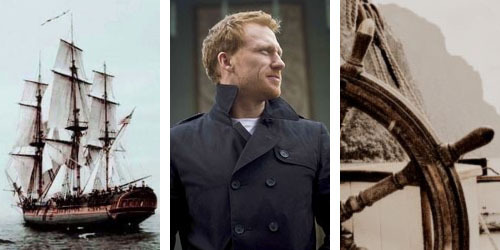
“We have met the enemy and they are ours…”
NAME: Willis Tibbs
AFFILIATION: Navy, HMS Victory
WEAPON OF CHOICE: Spadroon
OCCUPATION: Naval Captain
MAGIC STATUS: Mundus
When the ship that Willis Tibbs, a junior doctor and a navy man in training, was attacked by the Spanish, he assumed it would be the death of him.
Tibbs men had been fighting wars since there was a war to fight, and they had always fought on the winning side. Some had lost their lives for crown and country, but that didn’t seem to matter to the rest. When Willis had joined the navy, he didn’t think he’d see active combat. And then, all of a sudden, his Captain was dead, the First Mate, the Sailing Master, the Boatswain, the Gunner, even the surgeon under whom he was learning his trade, they were all gone. Willis, just seventeen years old, was the only man left aboard with enough fight to take control. He rallied the men, got them to man the cannons and ready the lifeboats, and though their own ship sunk, they sunk that Spanish galleon as well, and watched as it disappeared beneath the Mediterranean.
When what was left of the crew made it to Gibraltar, they hailed Tibbs as a hero, and for his bravery, he was given his own ship — the HMS Victory was christened in the Port of Gibraltar and went straight into her first battle. She spent ten years with Tibbs as her Captain, sailing the Mediterranean, engaging the French and the Spanish, and every battle they entered, they won. Their success was known within the British Navy, and when, upon his return to England, Tibbs was asked if he should like to retire, he politely rejected. He wanted a new challenge, with the Spanish war over. And with that, he was sent to the West Indies, and to Swynlake Port.
Swynlake Port was a funny place, but he found it a decent one. The waters in the Caribbean could be far more treacherous than those of the Mediterranean, but even then, the Victory seemed to come out of every battle alive and kicking. It was only recently, in a skirmish with some pirate vessel, that the Victory suffered some heavy losses. She was forced to return to the Port for repairs, and Tibbs was forced to look for new crewmates. And now, with news of the competition to crown the new Pirate King, the Victory’s focus, and that of her Captain, has been redirected solely to this new cause. Perhaps Captain Tibbs is cocky, after years of triumph, but he’s realistic; he knows the danger this race may bring, and he hopes those pirates are ready for a fight.
1 note
·
View note
Photo


Merry Christmas to @beomgyurk
| from @rkvok
First Edit/Drabble: Happy Christmas Jangmi! I’m so glad I got lucky enough to have you as my giftee! I hope you’ll like this little AU~
TW: Injuries, blood, slurs, prejudice and weapons
Genre: AU, Family, Fluff, Angst with a Happy Ending
Google Docs version
Second Edit: Happy Christmas (again~), Jangmi~
Hehehe, bet you didn’t think you’d be getting two gifts from me, hm? Truth be told, this was my first gift to you, but I though it was a little small orz. Hence the drabble I wrote for you too uwuIn any case, I hope you like both of these little presents and hope you have a wonderful Christmas~
Youtube Playlist!
~Bonds Beneath the Waves~
A sweet melody penetrates the air, a song of death disguised as a lullaby. As predicted, the boat deviates from its course, towards the young maiden on the rocks. She smiles, already knowing she has her prey with her grasp, her sky blue tail flickering slightly in anticipation. Her voice lilts higher and louder, carried by the wind to the sailor with a vacant smile on his face. Just a little more and…
Her song is suddenly cut short to be replaced with an inhuman shriek of shock and anger as a wave of water suddenly cascades over her. The hapless seaman forgotten, Yoona twists to where she knows the unwelcome surprise came from, her suspicions confirmed as she meets a pair of mischievous brown eyes which suddenly dart out of sight in a flicker of red and black. Without a second’s hesitation, she dives into the sea, intent on making the younger merman pay.
“MOONBOK!”
The only answer is a victorious cackle, her cousin sparing her a shit-eating grin as she chases him. His ornate tail kicks up sand and water in his attempt to buffer Yoona enough to make his escape. Because despite his playful attitude, Moonbok knows that once his cousin gets her hands on him, it’s all over. His father and uncle (who didn’t like him to begin with) would end him, if Yoona didn’t beat them to it. Still, he looks back again, that grin back on his face as he beholds Yoona’s expression.
“Maneater, maneater~! Noona is a maneat-uaaaaaghhhh?!?!”
Moonbok’s taunts are cut short as his tail gets tangled in a patch of seaweed he’d missed while teasing the older mermaid. With a panicked noise, he only manages to entangle himself further before Yoona catches up with him. And as Moonbok had feared, her retribution is swift and merciless.
The older girl tackles him with enough force to propel him out of the seaweed, one of her arms lock around his torso while the other scrabbles to seize whatever part of him she can reach. (Moonbok has no doubt it would be his throat.) But while his cousin has the element of surprise to her advantage, he has his strength; though he looks small and delicate, he is far more powerful than he appears. He fiercely wriggles and grapples with her, smacking his tail (gently) against Yoona’s until he manages to free himself and the chase begins again. They scatter fish and other merpeople in their wake, both of them ignoring the annoyed looks and chiding comments.
“You’d think the children of nobility would behave better than this!”
Alas, the chase ultimately ends in Yoona’s victory as she manages to use her agility to her advantage, popping up in front of her cousin and pinning him to the seabed before he can do anything more than let out a startled yelp. Having finally subdued the younger, she delivers a swift whap of her tail to his, rolling her eyes at the over-dramatic wail that’s his response.
“Oh get over yourself, I didn’t hit you that hard!”
Moonbok lets out another put on whine, unable to suppress his grin despite the situation. Gently, but insistently, he wriggles and whines until Yoona relents and releases him, a smile on her own face at last. Giving himself the once-over and shaking his tail out, which turns his lower half a blur of black and red that makes Yoona laugh, Moonbok affectionately bumps foreheads with her, his grin gone from mischievous to warm and soft.
“Sorry, noona. But if Uncle had found out you’d been luring more humans to the rocks…” he trails away, making sympathetic face in response to Yoona’s disgruntled expression. Even if Yoona’s father mistrusted and hated humans, he still forbade leading them to their deaths for no discernible reason. As expected of the Elder of their clan.
“I just wanted to sing…” Yoona mumbles, a pout on her face. At her Moonbok’s raised eyebrow and ‘are you for real?’ look, she snorts and gently shoves his shoulder.
Alright, so she did want to make the humans suffer and pay for their misdeeds against their family, their kind and Mother Ocean herself. A hand encircling her wrist drags Yoona from her dark thoughts and she meets her cousin’s eyes again, seeing that while his expression is still its usual soft and gentle one, though also laced with concern.
The upset must have been showing on her face. She sighs and shakes her head before pulling him into a hug and running a hand through his black-green tresses.
“You’re a good boy, Bokkie…” she murmurs softly, releasing him from the hold and signalling for him to turn around and sit on the slab of rock beneath them. Once Moonbok has sunken down onto it, she drifts behind him, beginning to braid his hair, trying to restore some semblance of order to him before they returned to their families and the inevitable lecture that would be awaiting the both of them.
“They’re not so bad, you know. Humans. Yes, some of them are can be awful, but most of them are kind and treat the ocean well. Believe me noona, I’ve seen it when I go to the surface. I know you and uncle hate them, but…” Yoona lets Moonbok chatter on, a sad smile on her face.
Her cousin is so naive and innocent when it came to the surface world.
She’s terrified he’ll pay for it with his life someday.
~~~
Yoona’s fears almost come true within the next moon when she sees Moonbok being dragged from the ocean screaming and thrashing, torso covered in wounds. And his tail, his beautiful tail, impaled by a harpoon. Yoona can only stare in horror at first while Moonbok’s sister screams hysterically, and it’s not until her cousin is hoisted from the water completely does she react, racing to the surface. As her head breaks the water, she sees Moonbok’s seemingly lifeless body being pulled aboard a fishing vessel, jeers and disgusting comments coming from the sailors on board.
(The ’nicest’ comment is one musing about selling ‘fishboy’ to an aquarium. The rest Yoona blocks out as best she can)
Gritting her teeth, Yoona throws her head back, singing louder than she’s ever done before, determined to save Moonbok by any means necessary. It takes a few moments, but finally she entrances them, leading to the boat to the sharpest outcrop of rocks she can find. As the boat crashes onto the rocks and break, startling the humans out of their trance and into a panic, Yoona darts towards it, pure fury propelling her forward.
She leaps out of the water and onto the rapidly disintegrating deck, sparing the terrified and doomed men nothing more than an inhuman screech of rage, wrapping her arms tightly around Moonbok. The boat is pushed even harder onto the rocks, water crashing onto the deck and sweeping men to their deaths. Yoona leaves them to their fate, clutching Moonbok tightly and using her tail to propel them both back into the sea, to safety.
To where she prays her cousin can be saved.
~~~
It takes all of the magical knowledge their grandfather possesses and all of the healing abilities Moonbok’s father has amassed, but they claw the young merman back from the brink of death. When she hears the news, Yoona breaks down in her father’s arms, sobbing and thanking the gods for their mercy. It still takes a week for her cousin to awaken fully from the magically induced healing sleep he’d been under and in that time, Yoona learns that Moonbok had been attempting to free a school of fish from being captured and in the process had been harpooned under the belief that he too was a rare fish. Yoona curses the humans once more, these evil creatures that polluted her home and tried to take her cousin from her just as they had taken her mother all those years ago.
When she finally has permission to visit Moonbok, tears falls again as she beholds him lying on his bed, angry scars across his torso and his tail; once a mesmerizing gradient of black and red, marred by silver scales, indicating where the harpoon had pierced him. At her sob, Moonbok looks over and laughs weakly.
“Ah…. Noona’s crying. Uncle is gonna end me for sure this time.” he teases, pulling himself upright with a hiss of pain and in spite of Yoona’s protests. When Yoona only reaches for his hand, Moonbok lets out an unhappy noise and pulls her into as tight a hug as he can bear. (Which isn’t very tight, but it’s as warm and affectionate as ever, which is what really matters.)
“I thought you were… I didn’t think… I should have reacted faster, I’m so sorry, Bokkie.” Yoona whispers disjointedly as Moonbok withdraws from the hug to lie back down with a suppressed whine. Tilting his head to look at her, Moonbok shakes his own in response, trying and failing to look stern.
“Stop that, Noona. This isn’t your fault, it’s mine. I wasn’t careful enough and got caught, simple as.” The tone is matter of fact, leaving no room for argument. “What happened, happened. We can’t change it. Let these scars serve as proof of me being an idiot.” His lips quick into a smile. “Besides, I think my tail looks kinda cool now, right? I mean, I won’t be rushing out to get it wounded again, but don’t you think the new scales add a nice touch?”
And despite herself, Yoona laughs and not long after, Moonbok joins in, the sound causing her heart to soar.
He would be alright. Somehow she just knows it. And even if he got back into trouble; either with humans on their family, he’d still have her love and support.
No matter what.
5 notes
·
View notes
Photo

In Game:
Nicholas Biddle was one of the first captains of the Continental Navy during the American Revolutionary War, and a member of the Colonial Rite of the Templar Order.
Around 1770, in Martha's Vineyard, Biddle was talking with Benjamin Church, who intended to recruit him into the Templar Order. As the meeting progressed, Biddle first encountered Connor, an Assassin, where he quickly exchanged an insult with Faulkner, before the developing argument was cut short by Amanda Bailey.
Six years later, Biddle patroled the Colonial coast and naval trade routes while orchestrating British attacks with his Templar co-conspirators. The Randolph attacked Nantucket, claiming it was a British Loyalist post when it had actually sided with the Continental Army, in an attempt to further convince the Congress that more ships were needed. Biddle also planned to boost his reputation and service record in order to be promoted to the rank of Admiral over the entire Continental Navy fleet.
Soon after, the Randolph was assigned to escort La Belladonna, a French ship providing aid to the Continental war drive. However, the Randolph abandoned La Belladonna to be attacked and seized by Templar ships.
The Aquila, captained by Connor, came to La Belladonna's defense before the ships attacked. The two vessels then destroyed the formation of Templar ships, while Biddle observed the battle safely from a distance.
In 1778, in order to remove Connor as a threat to his plans, Biddle patrolled the Caribbean coast, successfully luring the Aquila into a trap. In this encounter, the Randolph attacked the Aquila with the aid of two Men-of-War. However, the Aquila destroyed the Men-of-Warand successfully disabled the Randolph's mast with a single broadside of chained cannonballs.
Following this, Connor and the Aquila's crew boarded and attacked the Randolph, during which Connor confronted Biddle on the quarterdeck, causing both crews to cease fighting and watch as the two captains dueled, with Biddle furiously vowing to make Connor suffer for the damage dealt to the Randolph.
Connor overpowered Biddle, until Biddle fired a shot at a gunpowder keg, causing both of them to fall below deck.

The two soon continued their duel, with Connor emerging victorious and wounding Biddle. While dying, Biddle justified his actions by claiming that he benefited and empowered the Continental Navy. He rebuked the Assassins, calling Connor a fool for not understanding or accepting his goals.
With his final words, Biddle asked Connor not to take the Randolph as a prize, instead allowing him to die and sink with his ship. Connor granted this request and left, igniting several barrels of gunpowder behind him, destroying the Randolph.
In Real Life:
Nicholas Biddle was born in Philadelphia in 1750, one of nine children to William Biddle (1698–1756) of the Biddle family, and Mary Scull (1709–1789). He went to sea at the age of thirteen, as a ship's boy aboard a merchant vessel trading to the West Indies. In 1770 he joined the Royal Navy, resigning in 1773 to accompany Captain Constantine Phipps on his expedition to the Arctic Sea. While on this voyage he became acquainted with Horatio Nelson, the future British Admiral and fellow member of Phipps' expedition.
Joining the rebel cause when war broke out, he was given command of the armed galley Franklin by the State of Pennsylvania. She served as a gunboat on the Delaware. He next received one of the five Captaincy postings allotted when the American Navy was organized on August 1st, 1775. Given command of the brig Andrea Doria, with fourteen guns, he was under command of Captain Esek Hopkins in the expedition to the Bahamas and at the taking of New Providence. There Biddle captured several merchant vessels.
On June 6th, 1776 he took command of the Randolph, with thirty two guns, being the first frigate launched for the American Navy. He took her to sea, quickly facing and putting down a mutiny by his crew, many of whom were former British prisoners of war. After the mutiny came a storm which forced him to port for repairs. Later that year, however, he sailed again, taking several prizes in a cruise off the Southern coasts including the H.M.S. True Britton. He then made a courier cruise to France. Upon his return he put into Charleston to have his ship cleared of bottom hamper.
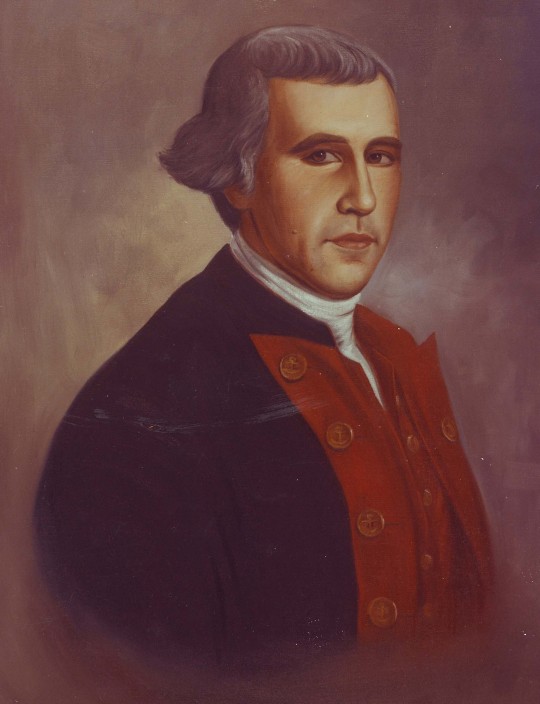
(Image source)
On March 7th, 1778, off Barbados, the Randolph engaged the British 64-gun ship-of-the-line HMS Yarmouth. Rather than trying to flee from the more heavily armed opponent, the Randolph engaged in battle. An eyewitness reported the frigate held her own in the twenty-minute engagement, appearing, "to fire four or five broadsides to the Yarmouth's one." After Biddle was wounded, the Randolph blew up suddenly, killing all but four of the 305 on board including Biddle. The loss of Randolph was a serious blow to the fledgling Continental Navy. His body was never found because was lost at sea.
Sources:
https://en.wikipedia.org/wiki/Nicholas_Biddle_(naval_officer)
http://justinmuseum.com/tjoschultz/biddle.html
http://www.revolutionary-war-and-beyond.com/captain-nicholas-biddle-is-born.html
8 notes
·
View notes
Text
Furniture on board a ship
Ships of the 18th and early 19th century were designed as floating gun platforms with an efficient discharge of guns. The fact that people also had to live there, and softly for years at a time, often fell a little behind. But at sea, people were clever and had furniture that was as practical as possible and could be folded up or stowed away as quickly as possible. At least above the waterline. The men didn't have that much space and the first lieutenant didn't always have a lot of room either. As First Lieutenant James Trevenen, HMS Crocodile, 24, guns off Cape Finistere, reported in a letter to his brother on 17 August 1781.

Une Chambre d' Officier à Board, by unknown mid 19th century (x)
My habitation, then is six feet square, which six feet is now completely filled up as an egg. My cot in which i sleep is two feet broad (c.61cm) and fivve and a half long (c.1,65cm), allowing half a foot (c.15cm) on each side for swinging (and this is too little when it blows hard). I wish i had not mentioned the cot, for it blows hard now and bring to memory that i shall have a bad night's sleep. Allowing half a foot then for swinging, my cot will take up just half my cabin and htere will be left six feet by three feet. A very small bureau will take up three feet square, and my chair and myself will pretty well complete the rest of the space. [...]
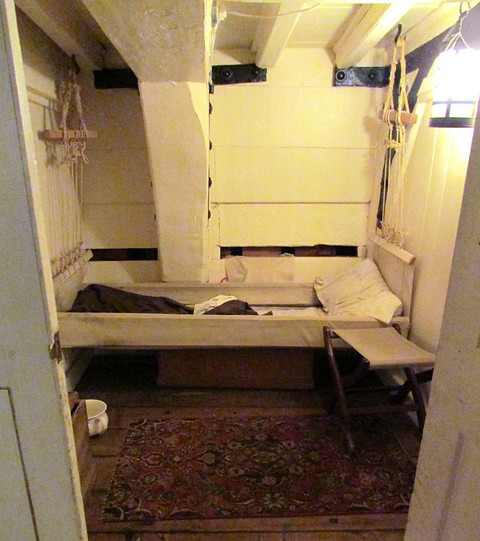
Officer’s cabin with cot, HMS Trincomalee (1817), photo by Simon Cotterill
It wasn't much space, let alone much furniture. But most of those who held the post of first lieutenant had an bureau in their cabin. Everyone else usually had a lapdesk (writing box) to do their writing properly. In addition, there was usually a small table and a chair, and possibly one or two shelves with a border so that the contents did not fly through the cabin. In addition, there was the swinging bunk, the sea chest and, depending on their means, all kinds of furnishings such as carpets, curtains, musical instruments, pictures, books and so on. So one person's cabin looked different from another's.
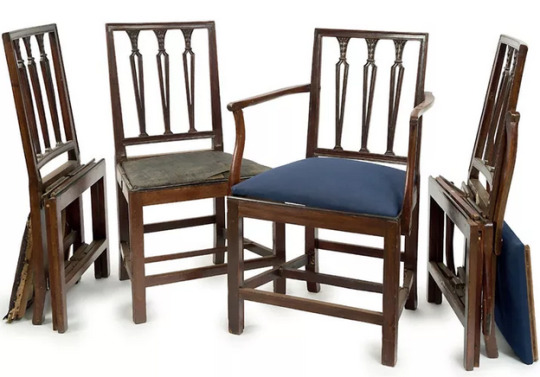
Mahogany naval chairs, 1795 (x)
In the great cabin, in addition to the office, the swinging cot and possibly one or two chests of drawers, there was also a large table and matching chairs. Depending on the type, these chairs could have been foldable or simply solidly made. The table might also have had folding or unscrewable legs. But many were also simply solid.

Admiral’s great cabin aboard HMS Victory - the walls are lifted up
All the furniture was made of mahogany, moveable and able to be lashed and, with a few exceptions, was provided by the Navy Board as fixed furnishings.

Captain’s day cabin abord HMS Victory (x)
Private items also had to be purchased privately and brought on board. These included the lieutenants' chests of drawers, washstands, sofas and harbour beds (these were folding beds used mostly in the harbour - Nelson had one of these).

Nelson’s portable bed (x)
If everything had to be cleared during a battle, the partition walls were hauled out or lifted up under the ceiling. All furniture and personal belongings had to be moved to the hold so that they would not be damaged. And hopefully they did, although it often happened that the good furniture was damaged. When the battle was over, everything was put back in its place and everyday life resumed.
327 notes
·
View notes
Note
favorite maritime anecdotes?
Here’s fifteen
1. “Somewhere during this period, I came across another small, telling anecdote that reveals more about the spirit of the destroyer’s crew. After the bombing in the Flores Sea, Houston lost not only her number three turret, cold storage locker, and crew’s head as well as three searchlights and two motor launches; her laundry was also destroyed. At that point the men of Edsall volunteered to provide laundry service for the cruiser. Bob Fulton told me that the last time he saw Edsall was when his clothes were being lowered over the port side of Houston’s quarterdeck to the destroyer. As he put it, “I don’t know where that brave ship is today, but wherever she is, my clothes are still aboard.””
–A Blue Sea of Blood: Deciphering the Mysterious Fate of the USS Edsall, by Donald M. Kehn
2.

3.
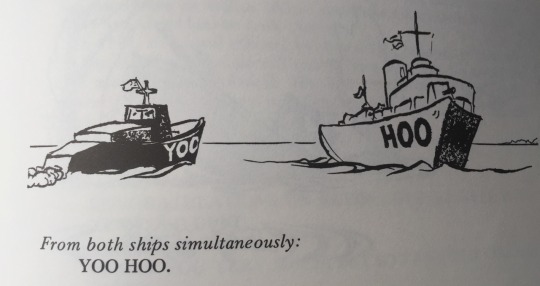
4. “On one of those raids the steering wheel [of USS Salt Lake City CA-25], loosened by the jar of the firing, fell off. The helmsman held it up in his two hands. And he turned to the captain with deference. “Sir,” he said, “what do I do with this now?” “Switch steering to auxiliary steering aft,” ordered the sweating Captain. The crew fell into a certain nonchalance about combat. At Saipan the officer of the deck accepted a line from a tanker and started fueling while an air attack was going on at an island two miles away. During one bombardment some genius of the commissary discovered caviar left over from a gala in San Francisco a year before. Officers off duty munched it in the wardroom while the guns roared. Off Okinawa, Poncho Miller, the boss of the lookouts, reported calmly, “Jap Betty (a bombing plane) is directly overhead.” “Signal it to keep going,” was the reply. “
5. From Enterprise, by Barrett Tillman (the practice was for escorting destroyers to rescue shot down pilots, and they’d bring them back to the carrier in exchange for five gallons of ice-cream, for carriers had icecream makers, but for the most part destroyers did not,)


6. “An ensign who graduated from the Naval Academy during Hart’s tenure as superintendent was considerably unnerved when he heard that Hart was the admiral who was coming to inspect his ship. When Hart came into the bridge, he seemed just as formidable as ever and, to test the alertness of the engine-room crew, he walked over to the voice tube and shouted into it: “If eggs are five cents apiece, how much would a dozen cost?” To the horror of the ensign, the reply came back: “Shut up, you dumb son of a bitch, don’t you know we’re being inspected?” Hart showed just a twitch at the corners of his mouth. “They are alert,” he announced.”
— A Different Kind Of Victory: A Biography of Admiral Thomas C. Hart, by James Leutze
7. “Lt. (j.g.) John J. A. “Jack” Michel of Pope had grabbed the final boat back to his destroyer after getting his “fill” of San Miguel beer at the Army-Navy Club. He expected, with no pleasure, that his ship would again be conducting minefield patrols again the following week. Weather conditions on Manila Bay that night were typical according to Michel: “sticky [and] breathless.” He eventually fell asleep in his sweltering miniature stateroom, in spite of its dysfunctional ventilator and location next to the forward fire room. In the middle of that momentous night—and no doubt still damp with beery perspiration—he was awakened from his slumbers to be told, “I don’t suppose you’re particularly interested right now, but Pearl Harbor was bombed and we’re at war with Japan.” Michel could only mumble, “The bastards,” before going right back to sleep.”
— In The Highest Degree Tragic: The Sacrifice of the U.S. Asiatic Fleet during World War II, by Donald M. Kehn
8. From Signals from the Falklands, by John Winton
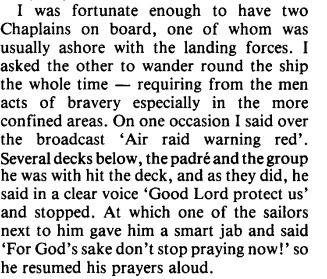
9. “Lieutenant Pat McEntee in the Atlanta witnessed it: a Wildcat closing fast on a Betty from behind. The fighter was evidently out of ammunition, for its driver resorted to an unusual tactic. Down came his landing gear. Down went his airspeed. It looked to McEntee as if he was trying “to set his ship down on the bomber’s broad back. And he did—again and again, and again, with sledgehammer impact. He literally was pounding the enemy into the sea with his wheels.” The bomber pilot had no escape. If he tried to pull up, it only increased the force of the impacts. Any evasive turn was easily matched by the agile fighter. “The only course open led down. But before the Jap could make a decision, something snapped under the pounding and the bomber plunged beneath the waves of Savo Sound.”
- James D. Hornfischer, Neptune’s Inferno: The U.S. Navy at Guadalcanal
10. “The first time the South Dakota’s main battery was tested with a full nine-gun broadside, the wave of blast pressure pushed through the passageway where Captain Thomas Gatch was standing, tearing his pants right off him. The vast power of the sixteen-inch guns required a perfect physical apparatus to ensure not only their working order but also the safety of the ship.”
-Neptune’s Inferno: The U.S. Navy at Guadalcanal, by James D. Hornfischer
11. “Electrician’s Mate John J. Kellejian’s battle station on the flag bridge often put him beside the task force commander. During a general quarters emergency drill there was little to do in flag country, prompting Halsey to ask Kellejian if he played cribbage. The youngster had never heard of it so the admiral exclaimed, “Don’t worry about it, son. I’ll teach you.” After a tutorial, Halsey declared the electrician ready to play, the stakes being a nickel a round. “I lost my ass,” Kellejian said, losing more than fifty games, but since sailors never had much money, the admiral seemed to forget the debt. Following Halsey’s death in 1959, Kellejian—long out of the Navy—received a summons from the admiral’s estate, demanding payment of a debt of $ 2.80. Kellejian phoned Halsey’s sister, who explained that Wild Bill had carried the amount as a joke to share with friends. The debt was forgiven, but John Kellejian kept the summons as a souvenir of his costly lessons at the knee of Admiral William F. Halsey.“–Enterprise, by Barrett Tillman
12. "Early that morning, the convoy came under attack from the USS Sturgeon, a submarine which fired a salvo of torpedoes and was rewarded with some satisfying explosions. These prompted the facetious signal “Sturgeon no longer virgin.” As no Japanese ship was actually penetrated, this claim was premature. So was the ejaculation of large numbers of torpedoes that night by the four old but dashing destroyers of Rear Admiral William A. Glassford’s Task Force 5, US Asiatic fleet, alerted by air reconnaissance from Java.”
–The Pacific Campaign, by Dan van der Vat
13. “USS Overton (DD-239), with two boilers inoperative, was sent to meet the speedy Queen Elizabeth 500 miles at sea, and escort her to port. Running her best speed in a full gale, she shifted fuel to the port tanks to counterbalance the force of the wind. Waves smashed the splinter shield of her bow gun, leaked through the forecastle deck, caused a six-foot crack in the main deck, carried away the bridge windshield, and washed two depth charges out of the racks, but the destroyer kept up the pace. When she finally hove to in the lee of the land, her unbalanced fuel tanks caused her to take a 33 degree list to port. But in the words of her skipper’s official report, ‘Other than this superficial damage, the ship had weathered the trip very well.’” – Flush Decks & Four Pipes, by Cdr. John D. Alden
14. “On 18 September, 1942, USS Barney (DD-149), while escorting a convoy from Trinidad to Guantanamo, rammed USS Greer (DD-145)’s stern. This dislodged depth charges that went off under Barney’s keel, forcing both to creep home to Charleston for repairs. After this, Greer seems to have made a career out of collisions, for she rammed and sank USS Moonstone off the Atlantic Coast, and on 30 November, while seeking to avoid a tanker, she was rammed amidships by USS Rapidan.”
–Flush Decks & Four Pipes, by John D. Alden Cdr US Navy (Ret.)
15. From HMS Rodney, by Ian Ballantyne

37 notes
·
View notes
Text
Royal Navy Prepares for the 75th Anniversary of VJ Day
The new Royal Navy carrier HMS Prince of Wales will help lead the UK's national commemorations marking the 75th anniversary of victory over Japan.
The previous HMS Prince of Wales was among the war’s first victims, sunk on December 10, 1941 as she and battle-cruiser HMS Repulse attempted to stop Japanese landings on the Malay peninsula. They were pounced upon by enemy bombers, and without air cover the two capital ships succumbed to the aerial assault in under 90 minutes, taking 840 men with them.
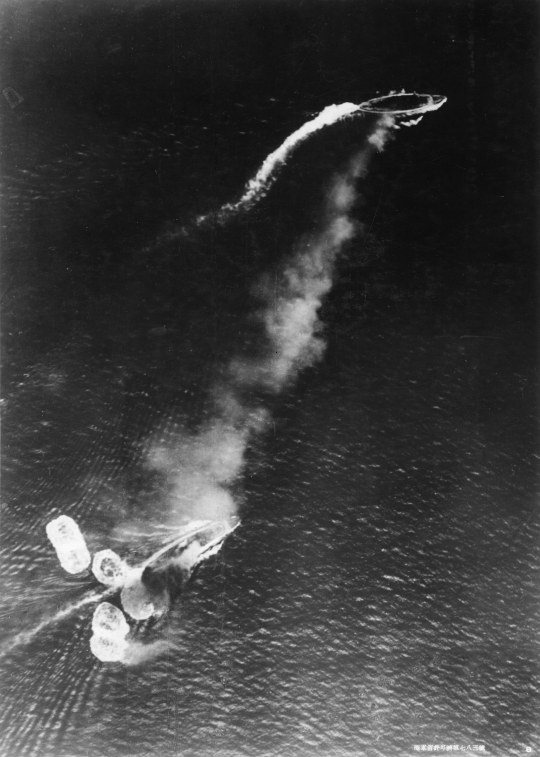
Prince of Wales and Repulse under attack by Japanese bombers
The crew of the new carrier will represent the Navy at the National Memorial Arboretum in Staffordshire, alongside veterans, families and descendants of those who strove to put an end to Japanese militarism. As with VE Day commemorations earlier in the year, plans have been scaled down due to the COVID-19 pandemic, and the public will not be able to attend the principal event at the arboretum. However, it will still be broadcast by the BBC.
Commemorations will begin Saturday at 0600 with performance by pipers around the world, including aboard the museum ship HMS Belfast (which was due to take part in operations against Japan in 1945 only for Tokyo to surrender), followed by a wreath laying at the Cenotaph in Whitehall.
Mid-morning, the focus shifts to the arboretum where the Duke and Duchess of Cornwall will be guests of honor, joining veterans such as former HMS Indefatigable crewman Albert ‘Les’ Wills, families and military personnel from units associated with the war against Japan.
The Battle of Britain Memorial Flight will perform a flypast over the ceremony. Eyes will remain fixed on the skies for much of the day as the Royal Air Force's aerobatic team stages a four-hour-long flyby over the four capitals of the UK, ending over the Royal Hospital Chelsea around 1730 hours.
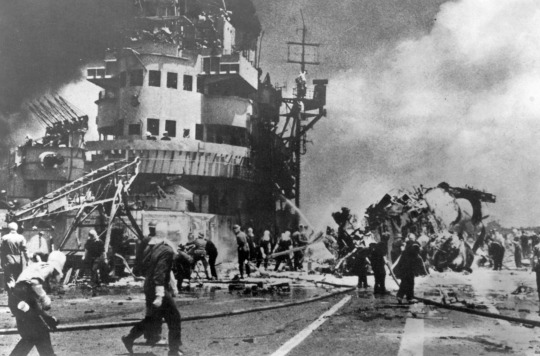
Kamikaze attack on HMS Formidable, May 1945
In the UK, the war in the Far East is generally overshadowed by the conflict against Nazi Germany in Europe, North Africa and the Atlantic. It nevertheless accounted for 71,000 of the Commonwealth’s war dead, 12,000 of them casualties of Japanese prison camps.
By the beginning of 1945, the Royal Navy had massed the greatest force in its history, the British Pacific Fleet (also known as "The Forgotten Fleet") for the final onslaught against the heart of the Japanese empire: four battleships, over 20 carriers, 11 cruisers, 35 destroyers, 31 submarines, more than a dozen frigates and scores of minesweepers, sloops, auxiliaries and escorts.
This story appears courtesy of Royal Navy News and may be found in its original form here.
from Storage Containers https://www.maritime-executive.com/article/royal-navy-prepares-for-the-75th-anniversary-of-vj-day
via http://www.rssmix.com/
0 notes
Text
take it from day to day
Read it on AO3
James grieves Sir John's death. Alone.
***
When the bustle of things dies do—falls away, James is left alone in the great cabin. In Sir John’s great cabin. Francis has agreed to one day of mourning before the rescue party sets out, and James is not so delusional as to believe that Francis missed the personal nature of the plea. They all saw him, watched him fall to his knees on the ice and scream his throat raw, watched him stagger back to the Erebus in a daze amid the scramble to get everyone back aboard.
He sits now in his habitual chair, head in his hands, and stares down somewhere a long way below his boots. This isn’t possible, he reminds himself. Sir John is often up on deck at this time, and in a few minutes his footsteps will sound on the stairs and he will appear in the doorway. This is perfectly normal. Because the alternative—that James watched the last trace of his coat disappear into the black water and saw that single leg lying obscene and bloody against the ice—is unimaginable. The memory is clear enough, but to believe that it happened as he remembers is to believe that Sir John is gone and James is the commander of HMS Erebus, and neither of those things can be true.
He waits. Minutes pass. No sound.
When the muscles in his hands start to protest how tightly he grips his hair, he sits up and lets his shaking arms rest in his lap. This cannot be. This cannot be. It is inconceivable. And yet so many parts of this voyage have been beyond anything he could have conceived.
Despite his denial, practicals keep seeping in at the edges. There will have to be a speech, of course, but it will be Francis who gives it. How will Francis inform the men of the Terror? No matter now. There will be time to fill in details tomorrow. He should sleep now so that his mind will be clear enough to support the men.
The grief hits him again in a wave and his chest aches. He grinds his teeth and squeezes his eyes shut, trying to contain tears already determined to spill over. There will be no reprieve, James knows from experience. He has never been adept at healing these wounds. Consuming, desperate sorrow will lap at him infinitely, each throb bearable in the moment but the endless assault wearing him down with time. The only victory available to him will be not to show it.
So he presses the heels of his hands to his eyes, swallows the exhausted sound trying to claw its way out of his chest, and rises to undress mechanically for bed.
2 notes
·
View notes
Text
Things I Learned About HMS Victory
The tallest man aboard at the time of Trafalgar was (William Bunce?) the ship’s carpenter who was a whopping 6’7”.
Captain Hardy himself was 6’4”
Admiral Nelson was killed by a musket ball that entered his left shoulder, punched down through his left lung and ended up lodged in the bottom of his right lung. He took three hours to die. Even today, with modern medicine, he would have been a goner.
There is still one gun from the Battle of Trafalgar left aboard the Victory.
Officers bunks were also their coffins.
The ship’s wheel would have taken four men to use on a calm day, and eight during a storm.
That big grey beast in the background of the photos is England’s new aircraft carrier, HMS Queen Elizabeth the Second.
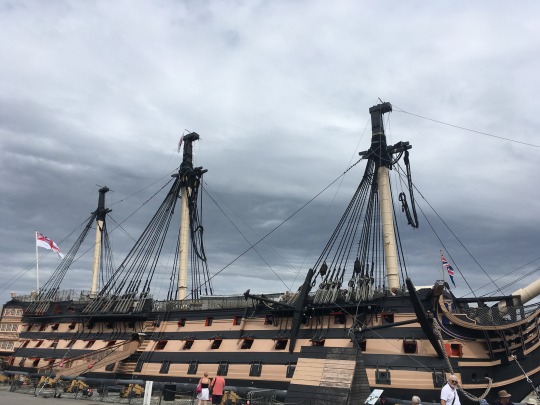
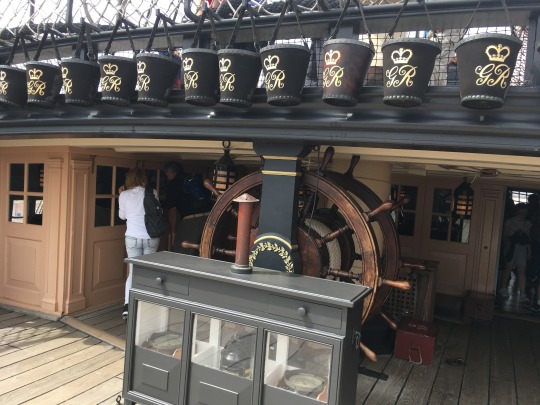
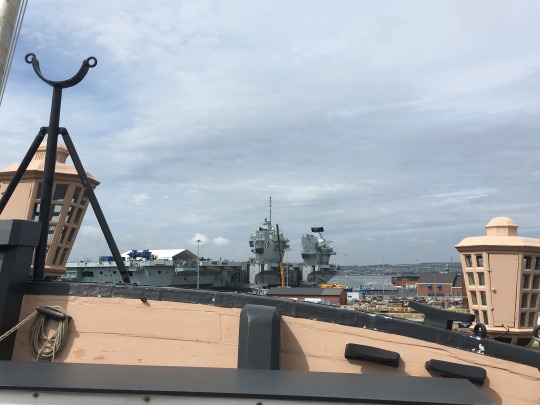
1 note
·
View note
Text
Dunkirk: Fuck, here we go again (not technically a review)
Attach Christopher Nolan’s name to something and said something becomes worth its weight in gold, held up next to the likes of Blade Runner, or Citizen Kane, year after year, and film after film. Interstellar had a stupid premise, idiot scientists who calculated time dilation but forgot about Newtonian gravity when deciding whether or not to visit a planet near a black hole, and no comprehension of the difficulties inherent in the colonization of another world. The Dark Knight had all the subtlety of a thermonuclear bomb, startlingly poor lighting, terrible acting, sub par action, and dull sets. For problems with Batman Begins, see The Dark Knight. Oh, and yes, mediocre soundtracks by that creativity black hole named Hans Zimmer, and always, without fail, a complete lack of well-rounded or well-written characters. Characters with tragic fates or backstories, thematically interesting goals, or twisted arcs perhaps, but never ones that haven’t been done before. When truly analyzed, the characters in Christopher Nolan films are merely artifices for theme, never people allowed to have characteristics that exist beyond the parameters of their operatic purpose.
Now, we have Dunkirk. Before I get going, I am making a criticism off of what the I have read and am currently reading about the film, and no I have not seen it, so before you get all hostile, I cannot call this a review because of that fact. It best considered an essay.
From what I’ve read, Dunkirk is of course coupled to a soundtrack written by Hans Zimmer which a BBC review written by Caryn James describes: “Hans Zimmer’s perfectly-modulated score is an understated mix of music and sound effects. It knits the movie together and contributes to the tension without manipulating emotions the way clichéd, soaring melodies do in old-fashioned war movies”. Translating that into more plain English, Hans Zimmer couldn’t be bothered to write a melody again. Also, the truly great older war films had soundtracks that understand the value of silence far better than modern films do, while still having soundtracks that stick with you. If you want good examples of this, watch Patton, Waterloo, Zulu, or A Bridge Too Far (which had soundtrack written by John Addison, who actually fought in Operation Market Garden as a member of 30 corps).
But that flaw is nothing compared a failure in concept. Dunkirk is a film that prides itself on showing one of the greatest logistical achievements of the Second World War from the soldier’s perspective, with minimal dialogue. While this may seem like an interesting idea on paper, the idea itself deprives the audience of information in my opinion. Dunkirk is best understood with the perspective of the planners of Operation Dynamo kept in view. The challenges faced by the need to scrape together sufficient resources to evacuate over 300,000 men from France in a matter of days make for interesting film. The background and context for the Battle of Dunkirk in my opinion demands that a General’s perspective be shown. I’m not saying that the soldiers should die while Generals get the glory, I am saying that the audience needs a greater understanding of the importance of Dunkirk, and to a soldier, the importance of one battle compared to another can be difficult to discern. Each battle contains the likelihood of being killed, crippled, or disfigured, be it stopping the enemy’s advance at the last minute, or simply running into an enemy patrol. Soldiers often die uselessly because of misheard orders, or poor tactical planning. They suffer, and the benefits of their suffering aren’t as readily apparent to them as it is to their leaders. To quote Tennyson: “Theirs not to make reply, theirs not to reason why, theirs but to do and die.” It isn’t that the soldier’s perspective is less relevant, it is very relevant. The perspective of a soldier best illustrates the stupidity, wastefulness and horror of war, the futility of it, its way of consuming and destroying young men with otherwise bright prospects. But to understand why battles are won or lost, and what victory or defeat in those battles means, one has to see things from the leader’s perspective.
I apply this to Dunkirk by describing to you what would happen from the perspective of a soldier in the British Expeditionary Force during the Battle of Dunkirk. First, the soldier arrives at the beach to await evacuation, and finds, to his dismay, that the fleet of ships sent to carry him back across the channel cannot reach him because of a lack of small boats to carry him aboard the ships. Then a civilian motor launch arrives to carry him to one of the larger vessels in the evacuation fleet, perhaps under attack by dive bombers. He survives the attack, and gets ferried home. Or maybe he doesn’t. It is a good enough perspective to hold the audiences attention, but it deprives us of any information the soldier does not have, especially since dialogue is kept to a minimum. While audiences in Britain are probably very familiar with the miracle of the little ships at Dunkirk, those who aren’t familiar, like us idiot Americans for example, will have only a vague idea of what happened at Dunkirk. I would consider making a movie about it to be an opportunity to educate them. One could put a text crawl at the beginning or end to provide the historical background that the soldier’s perspective doesn’t provide, but that is a fairly ineffective method. It is far more effective to add an additional perspective to the film, that of the Generals and Admirals struggling to get their men home. Why not include Admiral Bertram Ramsey’s planning of the evacuation in the bunker underneath Dover Castle? The same place British troops were garrisoned in the event of a French invasion in the time of Napoleon, the same castle where Henry II gave the famous outburst “Will no one rid me of this turbulent priest?” leading to the death of Thomas Becket. Why not include Admiral Wade Wake Walker as a character, show him transfer his flag to a lowly torpedo boat, MTB-102 (which did appear in the film, although in what capacity I’m not sure), following the sinking of his previous flagship, the destroyer HMS Keith? Or have a preamble shown from the commander of the BEF, Lord Gort’s perspective, showing the hopelessness of his position? Why leave this absent? Because the great war films of old style have no relevance to Christopher Nolan.
A more ensemble approach, similar to that of A Bridge Too Far, showing both the General’s and common soldier’s perspective is far better suited for this. A Bridge to Far is the film I suggest you buy, rather than give Christopher Nolan an excuse to continue to tarnish every genre of film with his poison.
8 notes
·
View notes